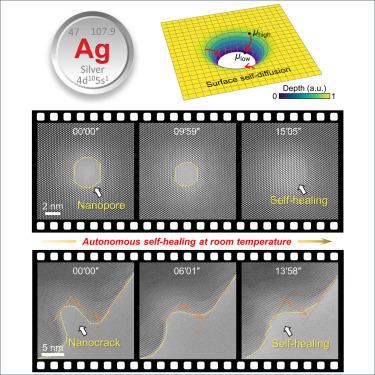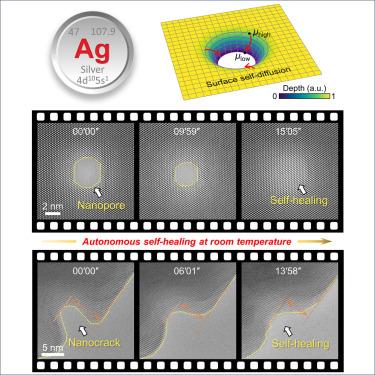直接观察银的自主自愈
IF 17.5
1区 材料科学
Q1 MATERIALS SCIENCE, MULTIDISCIPLINARY
引用次数: 0
摘要
虽然自愈合的概念最近在聚合物和其他软材料中再次引起人们的关注,但金属固体在没有任何外部触发的情况下自主自我修复结构损伤的情况却极为罕见。在此,我们报告了利用原子分辨率透射电子显微镜(TEM)在纳米级银(Ag)中直接原位观察到的这种自主固态自愈合行为。观察到两种具有代表性的结构损伤--纳米孔和纳米裂缝--在室温和远低于室温(低至 173 K)的条件下进行自动自我修复,无需任何外部干预。重要的是,金(Au)在室温下不会出现这种自主自修复现象,因为它受到已知相对论效应产生的更强金-金键的阻碍。原子成像和分子动力学模拟的结合揭示了自愈合过程是通过表面介导的银原子扩散完成的,而扩散是由吉布斯-汤姆森效应导致的化学势不平衡驱动的。本文章由计算机程序翻译,如有差异,请以英文原文为准。


Direct observation of autonomous self-healing in silver
Although the concept of self-healing has undergone a recent resurgence of interest in polymers and other soft materials, it is extremely rare for metal solids to autonomously self-repair structural damage without any external trigger. Here, we report on the direct in situ observation of such an autonomous solid-state self-healing behavior in nanoscale silver (Ag) by utilizing atomic-resolution transmission electron microscopy (TEM). Two representative kinds of structural damage—both nanopores and nanocracks—are observed to undergo automatic self-repair at room temperature and well below (down to 173 K) without any external intervention. Importantly, such an autonomous self-healing phenomenon does not occur in gold (Au) at room temperature, as it is hindered by the stronger Au-Au bonding resulting from the known relativistic effect. A combination of atomistic imaging and molecular dynamics simulation unravels that the self-healing process is accomplished through surface-mediated diffusion of Ag atoms as driven by chemical potential imbalance due to the Gibbs-Thomson effect.
求助全文
通过发布文献求助,成功后即可免费获取论文全文。
去求助
来源期刊

Matter
MATERIALS SCIENCE, MULTIDISCIPLINARY-
CiteScore
26.30
自引率
2.60%
发文量
367
期刊介绍:
Matter, a monthly journal affiliated with Cell, spans the broad field of materials science from nano to macro levels,covering fundamentals to applications. Embracing groundbreaking technologies,it includes full-length research articles,reviews, perspectives,previews, opinions, personnel stories, and general editorial content.
Matter aims to be the primary resource for researchers in academia and industry, inspiring the next generation of materials scientists.
 求助内容:
求助内容: 应助结果提醒方式:
应助结果提醒方式:


